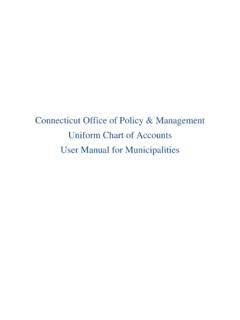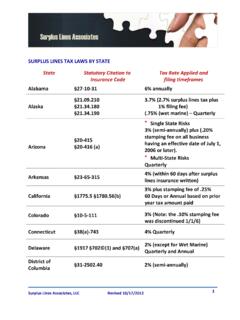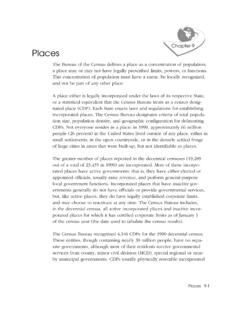Transcription of STANDARD OPERATING PROCEDURES
1 1 WINDSOR VOLUNTEER fire department STANDARD OPERATING PROCEDURES Original created December 1992 Revised in August 1995 2nd Revision August 2003 3rd Revision October 2011 2 WINDSOR VOLUNTEER fire department STANDARD OPERATING PROCEDURES Table of Contents Introduction and Mission Statement .. 10 ORGANIZATION .. 15 Qualifications for Membership .. 15 Membership Classification .. 16 Firefighter Levels .. 16 Explorer Firefighters .. 17 Probationary Period .. 17 Completion of Probation .. 18 Physicals .. 18 Company Membership .. 18 Number .. 18 Transfers .. 18 Officers .. 19 Term of Office .. 19 Officer Selection and Promotion .. 19 Officer Qualifications .. 20 Discipline .. 21 DUTIES AND RESPONSIBILITIES .. 22 General .. 22 Officers .. 22 SAFETY .. 25 Safety Committee .. 25 3 Personal Equipment .. 25 CLASS II HIGH VISIBILITY VESTS.
2 26 BREATHING APPARATUS .. 26 PERSONNEL ACCOUNTABILITY SYSTEM (PAS) .. 28 General .. 28 Personnel Identification Tags (PIT) .. 28 Company Identification Tag (CIT) .. 28 Hazard Zone and Point of Entry.. 28 Accountability Officer and Status Board.. 28 Operation of PAS .. 28 TRAINING .. 29 Personal Protection.. 29 Observer.. 29 Equipment.. 29 Structures.. 29 Burning Drills .. 29 INDIVIDUAL BEHAVIOR .. 30 REHABILITATION .. 30 Responsibilities .. 30 Rehabilitation Area .. 31 HAZ MAT .. 32 EVACUATION.. 32 WEATHER .. 32 INFECTIOUS DISEASE .. 32 4 WIRES DOWN .. 33 REGULATIONS .. 34 General.. 34 Suspension.. 34 Dismissal.. 34 Maintaining Membership Eligibility.. 34 Leave of Absence.. 34 department Regulations .. 34 Attendance STANDARD .. 35 Light Permits:.. 36 Facilities.. 36 Equipment .. 37 Refreshments.. 37 Parades.. 37 Funerals.
3 38 Appearance and Conduct .. 38 Discipline by Officers of the department .. 39 Appeal Procedure.. 39 Appeal Committee .. 39 Demotion .. 40 Injured Members .. 40 OPERATIONS .. 41 INCIDENT COMMAND SYSTEM .. 41 Definitions.. 41 5 Command Structure.. 41 Command Functions .. 42 Command Post.. 42 Sectoring .. 42 Communications.. 43 Staging.. 43 DISPATCH PROCEDURES .. 44 RESPONSE: .. 45 RADIO PROCEDURE .. 46 APPARATUS OPERATION.. 49 Driving Apparatus.. 49 Driver Qualifications .. 49 3 Response to Emergencies .. 49 Driver Duties.. 49 Safety .. 50 Speed Limits .. 50 Apparatus Checks .. 50 Riding Apparatus .. 50 Backing Apparatus .. 51 Company Engineer.. 52 Duties of Company Engineer .. 53 HAZARDOUS MATERIALS OPERATIONS .. 53 FIREGROUND OPERATIONS .. 54 Apparatus Placement .. 54 6 TYPE OF OPERATION .. 55 OFFENSIVE OPERATION.
4 55 DEFENSIVE OPERATION.. 55 Attack Lines .. 56 Supply Lines.. 56 Tank Truck Operations .. 56 Truck Company Operations.. 57 Ventilation .. 57 Order of 57 fire Flow.. 57 Initial Report.. 57 Rapid Intervention Team .. 58 Organization .. 58 Equipment.. 58 Location .. 58 Timing .. 58 Duration .. 58 High Rise Operations .. 58 General .. 58 Command Post .. 59 Operations.. 59 Apparatus Location .. 59 Staging - Firefighters.. 59 Equipment.. 59 7 Elevators.. 59 Ventilation .. 59 Attack Lines.. 60 General .. 60 Search Rope Operations .. 60 General.. 60 Search Ropes .. 60 Other Equipment .. 60 Use .. 60 Packing Ropes .. 60 Deploying Rope .. 61 Search Team .. 61 Search Team Operation .. 61 Other Considerations .. 61 Other Emergencies .. 61 Medical Emergencies.. 61 Rescue 62 Rescue 62 May Day Procedure Missing or Trapped Firefighters.
5 63 Bomb Threats .. 63 Landing Zone Protection .. 64 Carbon Monoxide Incidents .. 64 Unusual Situations .. 65 Search and Rescue .. 66 8 General .. 66 Organization.. 66 Equipment .. 66 Body Recovery .. 66 Property Recovery.. 66 Logistics .. 66 Mutual Aid .. 66 Incident Review .. 67 Duty Officers Vehicle .. 68 Tower 1 Response .. 69 Training on Motor Vehicles at the Firehouses .. 69 fire Explorers .. 70 TRAINING .. 72 Requirements.. 72 New Members .. 72 Regular Members.. 72 Officers .. 72 Safety Officer.. 72 department TRAINING .. 72 COMPANY TRAINING .. 72 OTHER TRAINING .. 72 DRIVER TRAINING .. 72 EQUIPMENT MAINTENANCE .. 74 Vehicles .. 74 9 SCBA.. 74 Ladders .. 74 Hose .. 74 74 Turnout Gear .. 74 PRE-PLANNING .. 75 General .. 75 Surveys .. 75 Plans .. 75 ADMINISTRATIVE .. 76 Record Keeping .. 76 Equipment Purchase.
6 76 Inventory Control .. 76 Membership .. 76 SOP Update Process .. 76 fire PREVENTION .. 77 MISCELLANEOUS .. 77 77 Keys .. 77 Storm Coverage .. 77 ATTACHMENT A MOTOR VEHICLE INSPECTIONS .. 79 ATTACHMENT B ENGINEERS PROFICIENCY TEST .. 82 ATTACHMENT C DRIVER EXAMINER S CHECKLIST .. 84 ATTACHMENT D AERIAL APPARATUS SET UP .. 86 10 Introduction and Mission Statement 1. INTRODUCTION This document provides a complete set of STANDARD OPERATING PROCEDURES (SOP) for the Windsor Volunteer fire department . All aspects of the fire department are included from organization through typical operations, which the department will be involved in. It is intended that this document will provide all of the guidance necessary for smooth and efficient operation of the department . However, it should be recognized that it is a set of guidelines and not a step by step description of each activity.
7 It should also be recognized that it may require modification from time to time as the department matures and as the regulations we operate under are modified. A common theme throughout this manual is SAFETY. The safety of the public and of all personnel involved in the operations of the department is our number one priority. Everyone must keep this in mind at all times. A copy of these SOPs will be provided to each member and copies will be available in each station. 2. ORGANIZATIONAL STATEMENT The Windsor Volunteer fire department was created at a Town Meeting held on June 17, 1991. This was established as a municipal corporation for the purpose of extinguishing fires pursuant to the statutory provisions of that time. The fire department boundaries were established and department Chief Officer was appointed by the Town Manager. In the years since its creation, the Windsor Volunteer fire department has evolved into a multi-discipline emergency service organization.
8 The entity of the fire department , the Windsor Volunteer fire department , provides fire prevention and suppression services in addition to emergency medical services, advanced rescue techniques, and hazardous materials containment and mitigation planning. Mission Statement The mission of the Windsor Volunteer fire department is to provide the services necessary to minimize the loss of life and/or property threatened by the hazards of fire , explosions, medical, chemical, and rescue related emergencies, through fire suppression, code enforcement, and conscientious prevention and education. The focus of the Mission Statement and a strategic planning effort shall be used to determine what services and the level of delivery which the department shall provide as a minimum to its taxpayers and guests visiting the community. The potential services cover a wide range of hazards and delivery parameters.
9 They include the following services: fire Suppression fire suppression operations are organized to effectively combat the types of fires that are likely to occur in the fire department . The priority goals of suppression activities are as follows: a.)Save lives b.) Limit the spread of fire c.) Extinguish the fire d.) Minimize the property damage from fire -related hazards Firefighters are trained and equipped to perform an aggressive interior assault on structure fires in order to accomplish the goals. Fires in structures present the highest probable risk to life and property in our department . This includes fires involving occupancies such as single and multiple family dwellings, health care facilities, educational facilities, hotels, stores, office 11 buildings, warehouses and various industries. There are various construction types common within the protection area ranging from wood frame detached buildings to sprawling strip malls constructed of concrete and steel trusses.
10 The department experiences a large risk of fire in non-structural locations and facilities. Outside fires involving brush, woods, propane and natural gas, and electrical equipment are not uncommon. The community also contains major highway and railway arteries, and is adjacent to an international airport. These transportation networks present the additional risk of fire in the respective vehicles and cargo. Rescue Multi-Discipline rescue services are provided to cover a number of technical situations. These types of rescues include but are not limited to: vehicle extrication, boat/water emergencies, and cold water/ice rescue. Hazardous Materials Personnel operate at the Operational level in accordance with the Town of Windsor Emergency Plan. A defensive strategy is stressed for dealing with hazardous material incidents. The mitigation of such incidents involves an eight-step process: site management, product identification, risk assessment, personal protective equipment, information/resource coordination, product control, decontamination, and termination.








